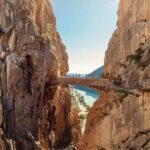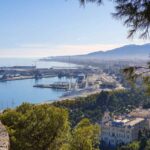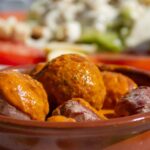Many of our best memories from our travels stem from just being spontaneous. They happen in the most unexpected ways, when you open your mind and embrace with all your heart your surroundings. It’s when our entire being is embraced by emotion, when we let go and just allow ourselves to fully live that special moment. It’s that first glimpse of Mulhacen, through the low clouds, on a rainy day. It’s the moment the ocean touches your feet for the first time. It’s that epic sunrise that turned the sky red, after you’ve hiked for hours up a very steep trail in the dark. It’s the taste of comfort food at a local hole-in-the-wall where you are the only foreigner. It’s that incomprehensive sadness you feel at the end of the trip, when you board the plane to go back home.
This is slow travel. All these moments are created by interacting with the locals, by trying the traditional food, and dancing to the rhythms of ethnic music. They happen when you immerse yourself in the local culture and take your time to discover it. Running from one place to another, ticking monuments and places on an infinite list of “things to see” will never have the same effect. I adopted the concept of slow travel more than 10 years ago, and since then I have been blessed with incredible moments and unforgettable adventures all over the world. In a way, slow travelling helps us to be better humans and to improve our understanding of each other, developing our empathy and our strength to be allies.
In this article, I want to tell you about slow travelling in Spain, about my experience meeting Felisa and Augustin Cabrera, two dreamers who created a small paradise on the slopes of a ravine, in Gran Canaria.
Felisa and Augustin’s Dream

After they retired, Felisa and Augustin Cabrera bought a piece of land on the outskirts of Telde, a small town on the eastern coast of the island, to follow their life dream of creating a vineyard in Gran Canaria. Located on the side of the ravine, the property is steep, sharply going uphill. With a lot of dedicated time and effort, the Cabrera family cultivated the land with vines, orange trees, and coffee plants, and built an ingenious rail line that climbs uphill and facilitates access to the highest parts of the property. Because of this unique piece of land and the way Cabrera terraced it, each vine receives the same amount of light, which translates into each grape tasting the same. After years of trials, and with the help of a winemaker, the Cabrera family developed their own small batch of artisanal wine: Señorío de Cabrera.

Now they are receiving guests at their small bodega, sharing with them the fruits of their labour, the produce of the land, and the wine fermented in their own cellar.
The Land

After a bumpy ride on an unpaved, dusty road, heading deeper and deeper into the heart of the Garcia Ruiz ravine, we reached the Señorío de Cabrera Bodega. We were greeted by two giant gentle dogs, full of life and ready to play.
As we passed through the gate, we entered the lush garden of Felisa and Augustin Cabrera, who were smiling broadly when they welcomed us. The driveway was covered with vines and full-size grapes hanging overhead. On the right-hand side, I could spot the chairs and tables through the garden, which was full of blooming flowers.

Whilst Felisa disappeared into the tiny kitchen, Augustin showed us around his land. Growing in the lower part of the garden were coffee shrubs. It’s that time of the year (June) when the fruits are almost ready. Nearby, under a canopy, were three trays filled with red coffee fruits, drying on top of rum barrels. Augustin explained the process of making coffee, from the plant to the cup. Did you know that the coffee fruits are sweet and that the bean we roast and grind is actually the seed?

The coffee that Augustin and Felisa make is smooth and aromatic, with very low acidity.
As we continued our journey uphill, we entered the vineyard. Cutting through the middle is a rail line and a small remote-controlled cart which helps bring down the grapes during harvest time. Augustin couldn’t be prouder of his unique rail! He invited us one by one to take a seat in the little cart and let ourselves be carried uphill, to the top of the vineyard. As we climbed slowly, Augustin told us the story of his black bird shaped kites flying in the wind above our heads, which he uses to deter real birds from his vineyard. He has to take them down every few days so that birds don’t get used to them and start ignoring them.

In his vineyard, Augustin grows four types of grapes: Listan Negro – a Spanish grape popular in the Canary Islands, Tintilla – a red Italian grape variety, Moscatel – a popular sweet grape variety, and Malvasia – a Mediterranean white grape.
The Bodega Señorío de Cabrera

Before we sat down for lunch, Augustin insisted that we check out his cellar, where his small batch of wine was ageing.
Guillermo, our guide, revealed that the wine master always tells Augustin off for opening the barrels during the ageing process. But Augustin is so proud of his wine that he just couldn’t help sharing it with us, his guests.
With a giant pipette he squeezed some of last year’s white wine production and poured it into our glasses. Even though it wasn’t quite ready, the wine was fresh, light, and highly aromatic. Perfect for a hot day!
The Feast

Once we sat down at the table just off the flower garden, Augustin brought us some white wine, this time in Señorío de Cabrera labelled bottles. Felisa followed with platters of local goat and sheep cheeses accompanied by fig, orange and mango jam, as well as the most delicious homemade croquettes: filled with chorizo for the meat eaters, and watercress for the vegans and vegetarians.
The main course was Ropa Vieja, a traditional Canarian dish consisting of shredded beef, potatoes and chickpeas, in a sweet, tomato sauce. For vegans, Felisa made a chickpea stew. I enjoyed the home-cooked dishes so much! Yes, the croquettes didn’t look plumped up, like the ones you get at a restaurant, they were so much more flavoursome. The Ropa Vieja was so good that even though I was already full, I couldn’t stop eating. Meanwhile, the wine kept flowing. When Felisa brought in the main course, Augustin changed the white for the red, which he decanted before serving.
For dessert, Felisa made us torijja – the Spanish version of French toast, drenched in local honey, which is unique to Gran Canaria.

It was impossible to leave Felisa and Augustin’s happy place. Augustin’s enthusiasm and Felisa’s contagious laugh made us spend the entire afternoon between the vines, enjoying good food and amazing company. When Felisa brought to the table their homemade liquors, blackberry and lemon, it was time for a salute. We toasted to their hospitality, to Gran Canaria, and to enjoying the small things in life:
“¡Pa arriba, pa abajo, pa’l centro, y pa dentro!”
Do You Want to Meet Augustin and Felisa?

Bodega Señorío de Cabrera is open to visits from small groups. A visit and menu usually costs 30 euros per person, and it is worth every penny. You must book the visit in advance, on this link.
Like it? Pin it!

Disclaimer: Some of the links on this website are “affiliate links.” This means that if you click on the link and do a purchase, I will receive an affiliate commission at no extra cost for you. This helps me keep my website running and continue to share my travelling knowledge with you. I thank you for booking your flights or hotels using the links on my website. Regardless, I only recommend products or services I use personally and believe will add value to my readers.
Please note that this article is a sponsored post promoting slow travelling in Spain.





What an incredible experience, thank you for sharing! My favourite part about slow travel is meeting the locals and immersing myself in the culture, love it!
What an experience! A great place to stay with wine and dogs!?! Sign me up!
You had me at vines, I love a good red! I would really like to explore more vineyards on my travels but it is difficult when you have a teen. Thanks for this info, I am inspired to add wine tastings to my itinerary.
Señorío de Cabrera sounds like a delightful winery. I love small tours with the owners or property managers. You can truly feel the love for what they do. I totally want to visit there when in Spain.